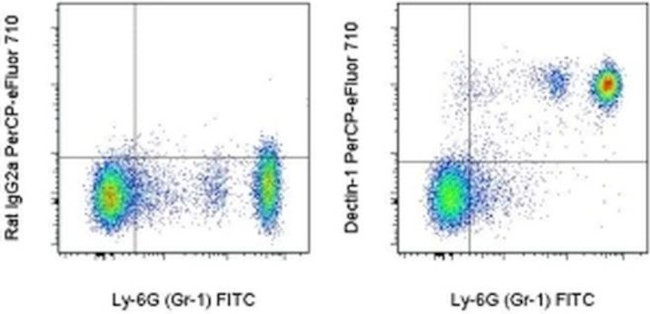Search Thermo Fisher Scientific
Invitrogen
CD369 (Clec7a, Dectin-1) Monoclonal Antibody (bg1fpj), PerCP-eFluor™ 710, eBioscience™
FIGURE: 1 / 1
CD369 (Clec7a, Dectin-1) Antibody (46-5859-82) in Flow

Product Details
46-5859-82
Species Reactivity
Host/Isotype
Recommended Isotype Control
Class
Type
Clone
Immunogen
Conjugate
Excitation/Emission Max
Form
Concentration
Purification
Storage buffer
Contains
Storage conditions
Shipping conditions
RRID
Product Specific Information
Description: The monoclonal antibody bg1fpj recognizes mouse CD369, also known as Dectin-1 or CLEC7A, a type II transmembrane protein in the C-type lectin family. The ligand is beta1, 3-glycan. Beta glycans are a main component in polysaccharides and specifically beta1,3-linked carbohydrates are found in the cell wall of fungi, plants and some bacteria. CD369 has been found to bind Candida, Aspergillis, Pneumocystis, Coccidioides and Mycobacterium. Calcium dependent binding to ligand signals through syk via the ITAM domain in the cytoplasmic portion and results in endocyotosis/phagocytosis and production of cytokines (IL-2, IL-6, IL-10, TNF alpha, IL-1 beta, IL-23). A direct role in Th17 and Th1 differentiation has been attributed to CD369 signaling. CD369 is expressed predominantly on myeloid cells (neutrophils, monocytes, macrophages, and dendritic cells). Low levels have also been reported on lymphocytes and mucosal epithelium.
Applications Reported: This bg1fpj antibody has been reported for use in flow cytometric analysis.
Applications Tested: This bg1fpj antibody has been tested by flow cytometric analysis of mouse peripheral blood cellls. This can be used at less than or equal to 0.125 µg per test. A test is defined as the amount (µg) of antibody that will stain a cell sample in a final volume of 100 µL. Cell number should be determined empirically but can range from 10^5 to 10^8 cells/test. It is recommended that the antibody be carefully titrated for optimal performance in the assay of interest.
PerCP-eFluor® 710 emits at 710 nm and is excited with the blue laser (488 nm); it can be used in place of PerCP-Cyanine5.5. We recommend using a 710/50 bandpass filter, however, the 695/40 bandpass filter is an acceptable alternative. Please make sure that your instrument is capable of detecting this fluorochrome.
Fixation: Samples can be stored in IC Fixation Buffer (Product # 00-822-49) (100 µL cell sample + 100 µL IC Fixation Buffer) or 1-step Fix/Lyse Solution (Product # 00-5333-54) for up to 3 days in the dark at 4°C with minimal impact on brightness and FRET efficiency/compensation. Some generalizations regarding fluorophore performance after fixation can be made, but clone specific performance should be determined empirically.
Excitation: 488 nm; Emission: 710 nm; Laser: Blue Laser.
Filtration: 0.2 µm post-manufacturing filtered.
Target Information
CLEC7A, also known as dectin-1, is a member of the C-type lectin/C-type lectin-like domain (CTL/CTLD) superfamily and is predominantly expressed on myeloid cells. It is a small glycoprotein type II membrane receptor with an extracellular C-type lectin-like domain fold and a cytoplasmic domain with an immunoreceptor tyrosine-based activation motif (ITAM). CLEC7A functions as a pattern-recognition receptor that recognizes a variety of beta-1,3-linked and beta-1,6-linked glucans from fungi and plants, and in this way plays a role in innate immune response. Upon fungal exposure, CLEC7A activates Syk tyrosine kinase, triggering a massive oxidative burst through the formation of reactive oxygen species.
For Research Use Only. Not for use in diagnostic procedures. Not for resale without express authorization.
How to use the Panel Builder
Watch the video to learn how to use the Invitrogen Flow Cytometry Panel Builder to build your next flow cytometry panel in 5 easy steps.
References (0)
Bioinformatics
Protein Aliases: beta-glucan receptor; C-type (calcium dependent, carbohydrate recognition domain) lectin, superfamily member 12; C-type lectin domain family 7 member A; C-type lectin superfamily member 12; DC-associated C-type lectin 1; dectin-1; dendritic cell-associated C-type lectin 1
Gene Aliases: beta-GR; BGR; Clecsf12
Entrez Gene ID: (Mouse) 56644

Performance Guarantee
If an Invitrogen™ antibody doesn't perform as described on our website or datasheet,we'll replace the product at no cost to you, or provide you with a credit for a future purchase.*
Learn more
We're here to help
Get expert recommendations for common problems or connect directly with an on staff expert for technical assistance related to applications, equipment and general product use.
Contact tech support

